I spent the last two weeks in Spain, combining business with pleasure. It’s interesting when something that starts out as part of the pleasure ends up being business instead.
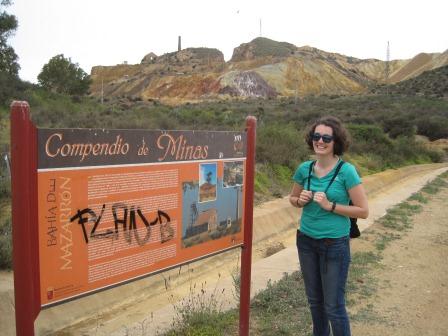
Charlotte translated this sign for me – it’s historical information. Note the brightly colored mine tailings in the background.
My daughter is teaching English in Mazarrón, a small town in the province of Murcia. The climate there is very similar to southern California, though drier and not as warm: it’s pretty much a scrubland ecosystem. Since we both enjoy hiking, we decided to take advantage of exploring the abandoned mine sites. Unlike such sites in the United States, there are no restrictions to hikers and in fact there’s signage explaining the history of the mines. This is a popular hike after a rainstorm because of the unnaturally red pools that form in the landscape.
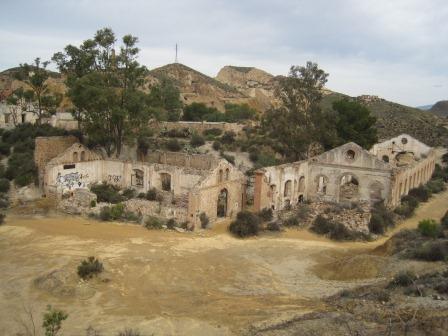
The abandoned mine works; these buildings are over 100 years old, though this area was mined since Roman times.
It took some Internet research to find out that lead, silver and zinc were the minerals of interest extracted from these mines. For those of you who aren’t aware of how ore processing works, it includes adding various chemicals to crushed rock to solubilize and isolate the desired minerals. The leftover tailings are nearly always highly acidic and full of environmentally available heavy metals. The various metal oxides and sulfides that formed at Mazarrón are vividly red, orange, and yellow, and there is a pervasive sulfur smell throughout the site. If this isn’t hell on earth, I don’t know what is.
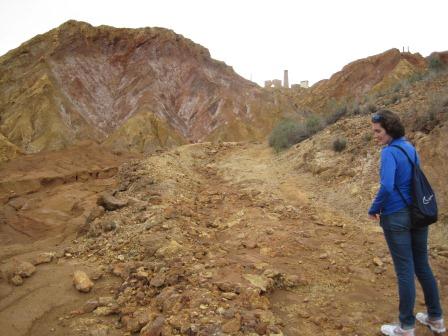
Mountains of mine tailings
So it was really quite a shock to both of us that not only could we walk into this mine site, but that there were no warnings regarding exposure to whatever toxic chemicals might be in the soil and water. We took pains not to touch anything – but others were not so cautious. Some hikers ahead of us watched their dog cavort through the largest of the pools, and later took photos of each other on the mine tailing spoils.
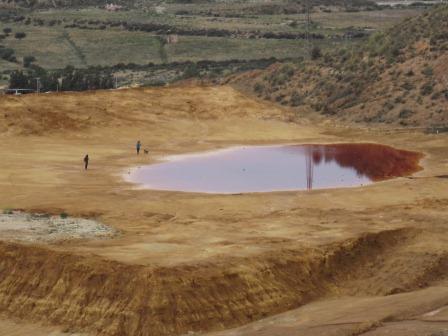
Visitors and dog and red pool of ????
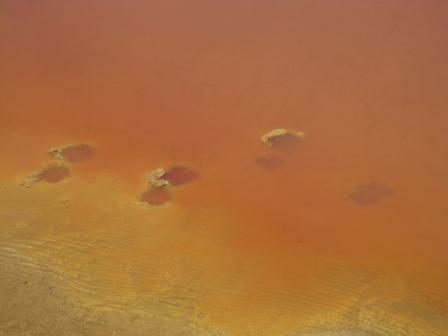 Yes, the dog went in the water
Yes, the dog went in the water

And then a photo op on the side of Spoils Summit
This hideously beautiful landscape was unearthly, primarily because there was absolutely nothing alive in it. No plants, no insects, no birds. Along the edges of the mine tailings there were spring flowering shrubs, bees, and birds, just as one would find elsewhere in the region. (But not in the spoils. What an apt name…)
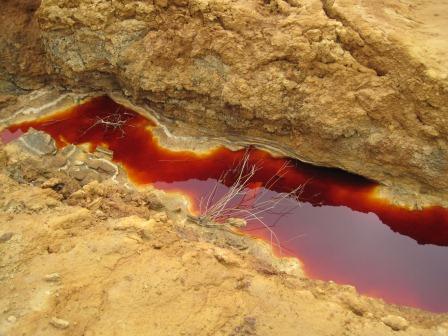
A blood-red seep into the pond
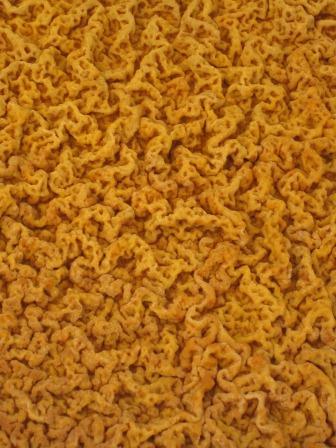
Crystals forming as water dries in the pools
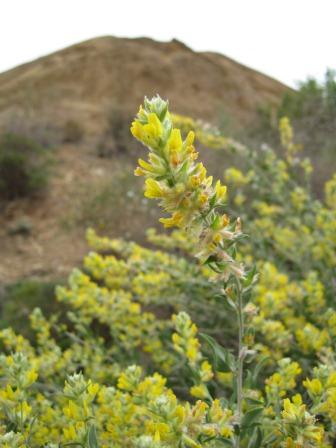
Just off the side of the tailings, life continues
How do the mines of Mazarrón fit into gardening? Unlike this mine site, where the evidence of heavy metal contamination was clearly visible, it’s not so obvious in our garden soils. The residues of arsenic-containing pesticides, leaded gas, zinc from car tire wear, and other possible contaminants are unseen and unknown unless we have soil tests done to confirm their presence or absence. Yes, it can be expensive to have these tests done, but if we are handling our soils, breathing the dust, and eating the plants that grow there, wouldn’t it be smart to find out what’s there first?
The earth bleeds. I guess death can be beautiful. I wonder what we are doing to the earth with the current energy boom in the US. Good point about the soil. What we don’t know can hurt us. I think of a case not too long ago about a development in what used to be an apple orchard.
This post interests me because it’s a topic close to home. I live a valley over from the largest open pit mine in the U.S., the Rio Tinto Kennecott Copper Mine. To supply the U.S. with most of its copper, they have literally mined away a mountain, leaving their flat-topped tailing piles so high that they are referred to as the “Yosemite buttes”. Part of granting permission to their continued operation has come with a highly detailed restoration plan, which is supposed to involve the restoration of the native plant population. But the area they need to cover is huge, covering a range from a montane zone to shrub steppe. I know from members of the native plant society that they have solicited advice in their restoration efforts, but I see little reported on it. They have built new-urbanist housing developments on reclaimed tailings piles already, but they have spent millions on groundwater contamination mitigation and the radon levels in these homes are through the roof. Most people don’t have to live with mining, but along the Wasatch mountains, it’s always with us.
“wouldn’t it be smart to find out what’s there first?”
That’s a good question- I’d like to know the answer as to whether the investment in testing a wide range of toxins is cost affective. Is there any particular research that might help sort that out, professor? How often have gardeners been shown to have suffered poisoning from tending and eating from their own gardens in this country? If it’s a know problem is it widespread or regional? Is it a one in a million possibility or more like one in a thousand and what are the consequences that have already been reported?
Here in the northeast, old orchard land often has copper arsenate contaminated wells which is usually tested before anyone buys land that was used for this purpose. But the concern seems to be primarily about the water and not the soil.
I’m not suggesting there’s not a problem, but a little more information would be useful. I have never heard of anyone suffering from contamination from their vegetable gardens so it is not on the top tier of my survival worries- at least not until I have some more info.
What do you consider to be “cost effective?” Are you putting a dollar value on health? If so, then yes – some communities, such as the Pierce County Health Department in Washington State, will do arsenic testing for free for its residents (there was a smelter in Tacoma that for decades pumped out arsenic and other contaminants.)
I’m sorry to tell you that there are hundreds of articles spanning at least 20 years looking at this problem in other parts of the world where home vegetable cultivation is necessary for survival. This country has virtually no published research on the potential risks associated with soil contamination and home vegetable gardens, probably because gardening is regarded as a “hobby” rather than a necessity. But that doesn’t mean the same contamination problems don’t exist here as they do elsewhere in the world – and given our industrialized history and legacy of arsenic-containing pesticides, it could even be worse.
Sounds a bit alarmist to me, Linda, and not your usual research first approach of analyzing problems and solutions. Analyzing soil contaminants is expensive- which ones do you propose the average gardener be looking for? How much of an investment is justified? Are you talking just about known contaminants in specific regions?
Of course there is always a cost to benefit assessment of what we decide to do to protect our health and that’s just a silly argument- as I think you know so I won’t waste my time writing obvious examples.
Alan, just because research hasn’t been done in the US yet doesn’t discount the decades of work done elsewhere in the world on this problem. I don’t know how my concerns could be construed as “alarmist” given that (1) we already know how deadly heavy metals are and (2) that the better known hotspots have been identified all over the country as EPA Superfund sites. See this website: http://www.epa.gov/superfund/sites/.
You don’t have to have your soil tested for every heavy metal – some are obvious (lead) and others are relatively easy to figure out if you know the history of land use in your area. Old agricultural areas should be tested for arsenic, for example, and areas that are downwind of known problems.